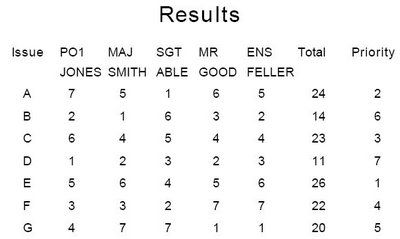Nemawashi and Nominal Group Technique
The Japanese have very different ways of conducting meetings or gaining consensus on an idea. This is termed Nemawashi and it is an informal process of talking to the people concerned, gathering support and feedback, so before a formal meeting starts, participants have already drawn conclusions regarding information to be presented at the meeting. The original meaning of the word is to smooth around roots before planting.
Whilst we may no be able to emulate this culture, we can use a methodology called Nominal Group Technique (NGT) to gain consensus; this is a structured method for group brainstorming that encourages contributions from everyone.
When should a team use NGT?
When a team needs to create a list of options and rank them, using NGT effectively neutralizes the domination of the loudest person, or the person with the most authority, over the decision-making process. This tool can also help a team achieve consensus about the relative importance of issues. The final result may not be everyone’s first priority, but they can live with it. NGT is a good tool to use when dealing with controversial or emotional issues, or when a group is stuck. It is particularly useful when you need to:
- Reduce the number of issues for easier handling.
- Get input from all team members.
- Rank items in priority order.
The process is outlined as follows:
- State the subject of the brainstorming. Clarify the statement as needed until everyone understands it.
- Each team member silently thinks of and writes down as many ideas as possible in a set period of time (5 to 10 minutes).
- Each member in turn states aloud one idea. Facilitator records it on the flipchart.
- No discussion is allowed, not even questions for clarification.
- Ideas given do not need to be from the team member’s written list. Indeed, as time goes on, many ideas will not be.
- A member may “pass” his or her turn, and may then add an idea on a subsequent turn.
- Continue around the group until all members pass or for an agreed-upon length of time.
- Discuss each idea in turn. Wording may be changed only when the idea’s originator agrees. Ideas may be stricken from the list only by unanimous agreement. Discussion may clarify meaning, explain logic or analysis, raise and answer questions, or state agreement or disagreement.
- Prioritize the ideas using multivoting or list reduction.
Example
A team is struggling with some problems in the workplace. The members identified the following issues:
A. Ineffective organizational structure
B. Poor communications outside the office
C. Lack of training
D. Poor communications within the office
E. Unclear mission and objectives
F. Poor distribution of office mail
G. Lack of feedback on reports to management
The team has some opinionated members who think they know the most important problem. Several team members, however, are not vocalizing their position. You decide to use NGT to prioritize the issues.
Each team member writes the letters A through G on a piece of paper. Then, each member ranks each issue from 1 to 7 (with the most important receiving 7 and the least important receiving 1), using each number only once.
Using NGT, the issues were prioritized as shown below. The issue the team will tackle first is item E, unclear mission and objectives.

Have you had experience in using NGT? Post a comment below ….

